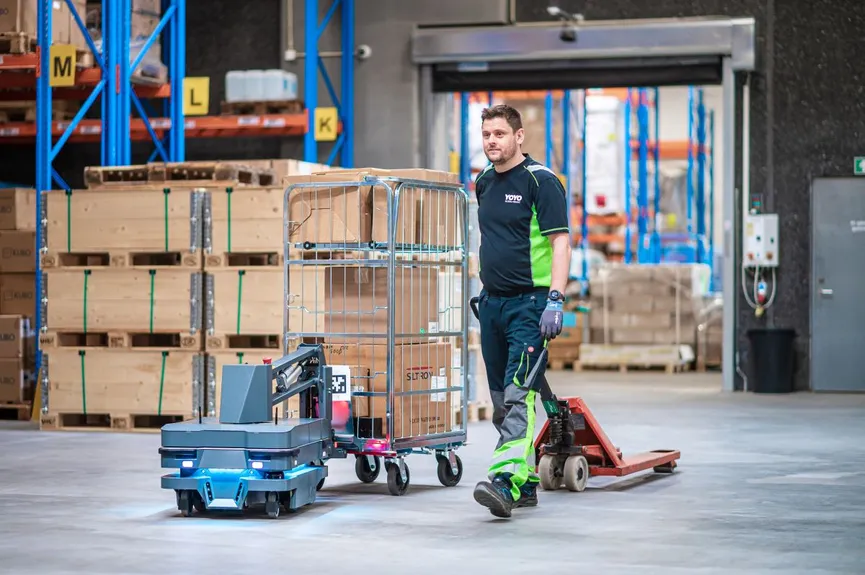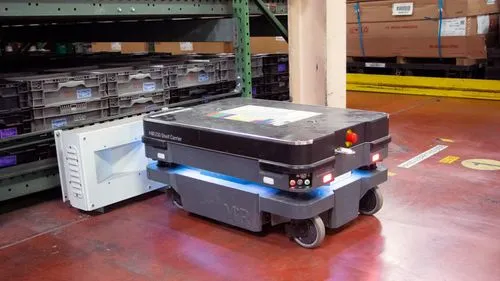5 easy steps to help your staff with automation
How can you make the automation process easier for your employees?
The rapid advance of automation and robotics means that some work tasks can now be done by machines and robots – from production- to material handling processes. Even though automation is often necessary for enterprises to increase productivity and keep costs down, these advances aren’t always welcome by employees. There is no denying that the word automation can evoke images of robots taking over jobs, and breed apprehension in employees. But automation can be a great tool for businesses, freeing employees from dirty, dull and dangerous tasks while boosting team effectiveness and creativity. The challenge for employers is often to communicate the benefits of automation and show people how it can change the future of work for the better.
Here we share some ideas on how to introduce new technology with positive impact on your workforce.

In short
Communicate your automation plans
If you describe the process and leave room for questions, employees are less likely to feel threatened or fearful about the change but instead engaged and interested.
Involve your employees in the process
Making your employees part of the process is the best way to smoothening your upcoming path to automation. Information gathered from employees is an excellent resource for deploying the robots most effectively.
Make the process enjoyable
Let your employees know that the future of work is not robots that are here to replace them, but rather that they will help and work alongside people, increasing efficiency but also safety.
Train your employees to work with the robot
Training your employees with the robot will help them to understand the robots and processes better. It will also give them new and valuable skills in their career
Familiarization with the robot
There are different ways of making your employees perceive the robots as part of the staff instead of a threat.
Insert video: 5 steps to make the automation process easier for your employees
1. Communicate your automation plans in good time
It is very important that you communicate what is going to happen to your employees. If you do not explain the process, this can create feelings of uncertainty amongst staff members. If you describe the process and leave room for questions, employees are less likely to feel threatened or fearful about the change but instead engaged and interested.
2. Involve your employees in the process
Making your employees part of the process is the best way to smoothening your upcoming path to automation. It is important that you listen to the workforce’s concerns and reluctance, so you can explain and correct misguided information. It is also crucial that you give them space to give ideas and make proposals. They are the people working daily with both current and future systems at the facility and therefore, they are the ones who can best identify points of interest within the space which could benefit from additional help and relief through automation. Information gathered from employees is an excellent resource for deploying the robots most effectively.
3. Make the process enjoyable for your employees
MiR AMRs take the most repetitive and heavy tasks, allowing your employees to focus on high-value activities. Help them to see that the robots are a tool for them to perform even better in their jobs. Rather than thinking that robots are being installed to take over their jobs, employees can see automation processes as something to work alongside. Let your employees know that the future of work is not robots that are here to replace them, but rather that they will help and work alongside people, increasing efficiency but also safety. E.g. MiR AMRs take over manual tasks that are usually met with high absences due to work injuries. Show your employees that the robots will help them have better health and better job results.
4. Train your employees to work with the robot.
Nobody likes something they do not understand, and automation does not work on its own. Training your employees with the robot will help them to understand the robots and processes better. It will also give them new and valuable skills in their career. MiR AMRs are easy to program and learn, and we also offer our free online learning platform MiR Academy, which can help your staff ease into working with robots and the new workflows surrounding them.
5. Make your employees familiar with the robot.
There are different ways of making your employees perceive the robots as part of the staff instead of a threat. Autonomous mobile robots are collaborative and therefore it is easy to “personalize” the robots for higher engagement of the employees. For example, asking your employees to name the robots is an excellent way to add fun and familiarity into the upcoming changes. Creating events around the robot, where the employees feel part of the integration process, can help them feel part of the change and be more proactive towards automation.


